 |
 |
 |
| |
Population Pharmacokinetic/Pharmacodynamic Analyses of Lopinavir and Ritonavir in Subjects Receiving the Tablet Formulation
|
| |
| |
Reported by Jules Levin
C Klein, J Ng, YL Chiu, PM Diderichsen, B da Silva, B Bernstein, W Awni
Abbott Laboratories, Abbott Park, IL, USA ♥ HIV 9 ♥ 9-13 November 2008 ♥ Glasgow, UK
AUTHOR RESULTS & DISCUSSIONS
The typical values of CL/F for LPV and RTV were estimated to be 5.58 L/hr and 22.8 L/hr, respectively. These values were similar to previously reported values based on noncompartmental analysis from the intensive PK subset of subjects at Weeks 2 and 10 (4.4-5.7 L/hr and 21.6-29.3 L/hr for LPV/r tablets, respectively).2
The typical values of CL/F for LPV and RTV were also compared to previously reported values based on noncompartmental analysis following SGC administration at Week 2 (5.3-6.3 L/hr and 31.2-32.5 L/hr for lopinavir and ritonavir SGC, respectively). The overall slightly lower CL/F values for the tablet suggested that bioavailability might be higher for the tablet relative to the SGC formulations.
In the analysis of potential covariates, only WTKG was found to be a statistically significant predictor of lopinavir CL/F. This is consistent with previous observations, in which subjects with lower body weights were more likely to have higher lopinavir Cmax and AUC values.4 While WTKG reached statistical significance for LPV CL/F, a 10-kg decrease in WTKG only resulted in a 4% decrease in LPV CL/F. This change is not clinically significant and further supports the use of fixed dose regimens in adults.
Dosing interval (QD vs. BID) was not a significant covariate for either LPV or RTV CL/F.
Race was not a significant covariate for either LPV or RTV CL/F. The dataset contained a sufficient number of blacks (N =112) to allow for the evaluation of this race effect.
Sex was also not a significant predictor of LPV CL/F. The dataset contained a sufficient number of females (N = 131) to allow for evaluation of sex effect.
In this study, baseline exclusion criteria included subjects with hepatitis B surface antigen and ALT or AST ≥3.0 x upper limit of normal (ULN). Therefore, in the group of HIV-HCV co-infected subjects with AST and ALT <3 x ULN at baseline, HCV co-infection did not significantly influence LPV CL/F in this study.
In this study, there were 79 subjects with mild renal impairment (CRCL >50-80 mL/min)5 and three subjects with moderate renal impairment (CRCL 30_50 mL/min)5. Creatinine clearance was not a significant predictor of LPV or RTV CL/F. The results support no change in LPV PK in mild renal impairment.
AUTHOR CONCLUSIONS
A population PK model for LPV and RTV was built for LPV/RTV following LPV/r tablet administration to HIV-infected subjects. Dosing interval was not a significant influence on LPV or RTV PK parameters. Weight was the only statistically significant covariate identified to affect LPV CL/F. The effect of weight is small (4% per 10 kg) and is not clinically significant. No significant covariates were identified for RTV CL/F, Vc/F or LPV Vc/F. A priori dose adjustment based on subject characteristics (race, sex, weight, etc.) is not warranted.
Virologic response did not correlate with LPV levels indicating that, even at the lowest levels measured in this trial, virologic response was maintained.
ABSTRACT
Study M05-730 was conducted to compare the safety, tolerability, pharmacokinetics (PK) and antiviral activity for once-daily (QD) and twice-daily
(BID) lopinavir/ritonavir (LPV/r) tablet in antiretroviral-naïve subjects. The LPV/r QD regimen was shown to be non-inferior to the BID regimen. This analysis explores the population PK and pharmacodynamics (PD) of the LPV/r tablets in HIV-1 infected subjects.
A total of 633 subjects (322 QD and 311 BID) were included in this analysis. Intensive PK samples were obtained in 69 subjects. Sparse PK was obtained up to Week 48 (up to 5 samples) in all subjects. The model-predicted ritonavir (RTV) PK parameters [apparent clearance (CL/F), volume of distribution (Vc/F) and absorption rate constant (ka)] were included in the population PK modeling for lopinavir (LPV). Covariate analysis (age, sex, race, weight, body surface area, creatinine clearance, dosing regimen (QD versus BID), hepatitis B/C virus, and alcohol use) was performed for RTV and LPV to identify potential covariates that may alter the PK profile. Individual LPV exposure (maximum concentrations
(Cmax), area under the curve (AUC) and predose trough concentrations (Cmin) were estimated. The relationship between these LPV PK parameters and antiviral efficacy (HIV-1 RNA <50 copies/mL) at Week 48 was evaluated using logistic regression. The following table presents the PK results.

None of the tested covariates had an effect on ritonavir PK. The only covariate that had an effect on LPV PK was weight for which a 10-kg increase in weight is estimated to result in a 4% increase in LPV CL/F. There was no association between LPV Cmax, AUC or Cmin versus virologic efficacy at Week 48 (p>0.1).
In summary, only weight had a small, statistically significant but not clinically relevant effect on LPV CL/F. A priori adjustment in LPV/r dose based on subject characteristics (race, sex, weight, renal function, etc.) is not warranted. The virologic response did not correlate with LPV levels indicating that, even at the lowest levels measured in this trial, virologic response was maintained.
BACKGROUND
Abbott developed a lopinavir/ritonavir (LPV/r) tablet formulation to reduce the total daily pill count from 6 soft gelatin capsules (SGC) to 4 tablets. Study M05_730 was designed to compare the safety and tolerability of the LPV/r tablet formulation to that of the SGC formulation and to compare the tolerability and antiviral activity of once-daily (QD) and twice-daily (BID) dosing of LPV/r tablets for 96 weeks. The pharmacokinetic (PK) profile for the LPV/r tablet formulation was compared to the SGC formulation in a subset of subjects at Week 2 and
Week 10.1,2
A meta-analysis of Phase 1 studies with earlier formulations of LPV/r in healthy volunteers previously demonstrated that LPV area under the curve (AUC) and maximum concentration (Cmax) were correlated with body weight while other demographic variables such as sex, race, and age were not significant predictors of LPV pharmacokinetics following administration of LPV/r.3 With the introduction of the tablet formulation of LPV/r, predictors of LPV PK following tablet administration were evaluated in a patient population.
OBJECTIVES
The primary objective was to explore the population pharmacokinetics (PK) of LPV and ritonavir (RTV) following administration of LPV/r tablets in HIV_infected subjects in Study M05-730.
The secondary objective was to evaluate the relationship between LPV PK parameters and antiviral efficacy (HIV-1 RNA <50 copies/mL) at Week 48.
STUDY DESIGN
Study M05-730 is a Phase 3, open-label, randomized, multiple-center, multi-country study designed to demonstrate the safety, tolerability, PK and antiviral activity of LPV/r in tablet formulation when dosed QD vs. BID, in combination with nucleoside reverse transcriptase inhibitors, in the treatment of antiretroviral-naïve, HIV_1 infected subjects.
A total of 664 subjects were randomized and received at least one dose of LPV/r in combination with QD tenofovir disoproxil fumarate (TDF) and emtricitabine. A total of 575 subjects completed the study through Week 48.
Dataset for Population PK Analysis
The dataset for LPV and RTV concentrations contained only data following administration of LPV/r tablets. Intensive PK data (0, 2, 4, 6, 8, 12 hours for BID/QD dosing and 24 hours for QD dosing) collected at Week 2 were included for subjects randomized to LPV/r tablets, and intensive PK data collected at Week 10 were included for subjects who were switched from the SGC to the tablet formulation at Week 8 of the study.
The final dataset contained 69 subjects with intensive PK data. Sparse PK data (a single plasma sample on Weeks 4, 8, 12, 16, and 48 or at the Discontinuation Visit) from 633 subjects were collected up to Week 48.
-- Samples with a missing drug administration date or time, or collected more than approximately 7 half-lives of LPV (45.5 hours) after the last dose of LPV/r,
and samples associated with suspected nonadherence (LPV and RTV plasma concentrations below the lower limit of quantitation, i.e., 5 ng/mL and 1 ng/mL for LPV and RTV, respectively), were excluded from the analysis. A total of 102 LPV and 103 RTV concentrations were excluded from analysis.
-- Following these modifications, 2620 RTV concentrations and 2619 LPV concentrations from 633 subjects were available for population PK analysis.
The pharmacokinetic sampling scheme for LPV/r tablets in Study M05-730 is shown in Figure 1.
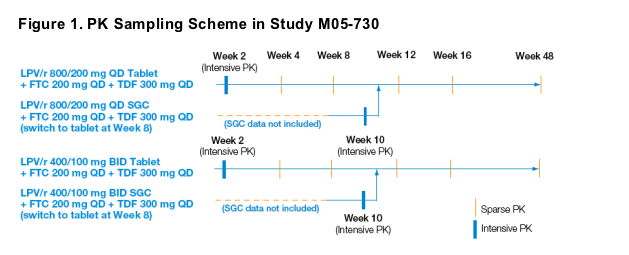
Population PK Model Building and PK/PD Analyses
Population PK models were built in a sequential manner. First, a population PK model for RTV was constructed to describe the relationship between the ritonavir dose, the plasma concentration-time data and potential covariates. Since RTV inhibits LPV metabolism, predicted RTV concentrations were used to model LPV concentrations in the second modeling step. Hence, the model-predicted individual RTV PK parameters were included in the population PK modeling for RTV. Covariate analysis was performed for both RTV and LPV to identify any covariates that would alter RTV or LPV PK.
The LPV and RTV plasma concentration-time data following administration of LPV/r tablets were modeled with a primary focus on the determination of apparent oral clearance (CL/F), apparent volume of distribution, central compartment (Vc/F) and absorption rate constant (ka).
PK models were fit to the data using the First_Order Conditional Estimation with Interaction (FOCEI) method in NONMEM. One-compartment models with first-order absorption and elimination were evaluated as the initial PK structural models for LPV and RTV.
Effects of age, sex, race, body weight in kg (WTKG), body surface area (BSA), treatment (TRT, QD vs. BID), Hepatitis B/C virus (HBV/HCV) co-infection, alcohol consumption, lamivudine co_administration and creatinine clearance (CRCL) were tested as covariates on CL/F and Vc/F in the PK model building process.
The relationship between these LPV PK parameters and antiviral efficacy (HIV-1 RNA <50 copies/mL) at Week 48 was evaluated using logistic regression.
RESULTS
Table 1 summarizes the demographic data for all the subjects (N=633) available for population PK analysis and summary statistics of the clinical covariates.
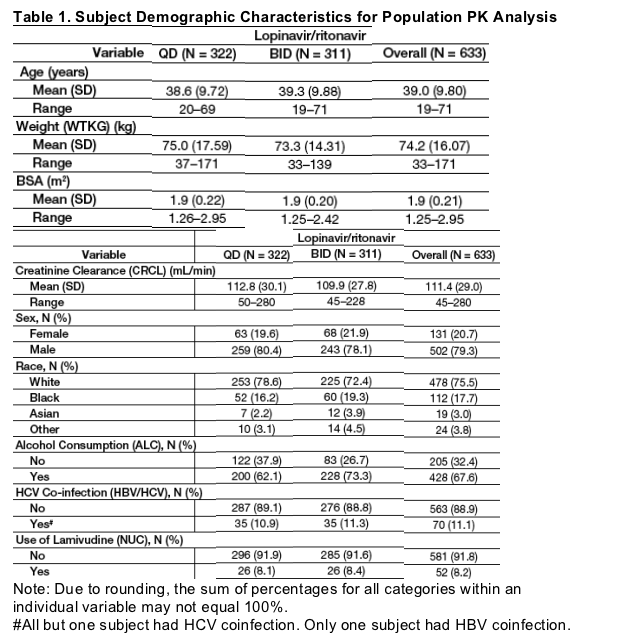
Note: Due to rounding, the sum of percentages for all categories within an individual variable may not equal 100%.
#All but one subject had HCV coinfection. Only one subject had HBV coinfection.
The estimated PK parameter values, their associated standard errors and the corresponding 95% confidence intervals for the LPV and RTV final models are listed in Table 2.
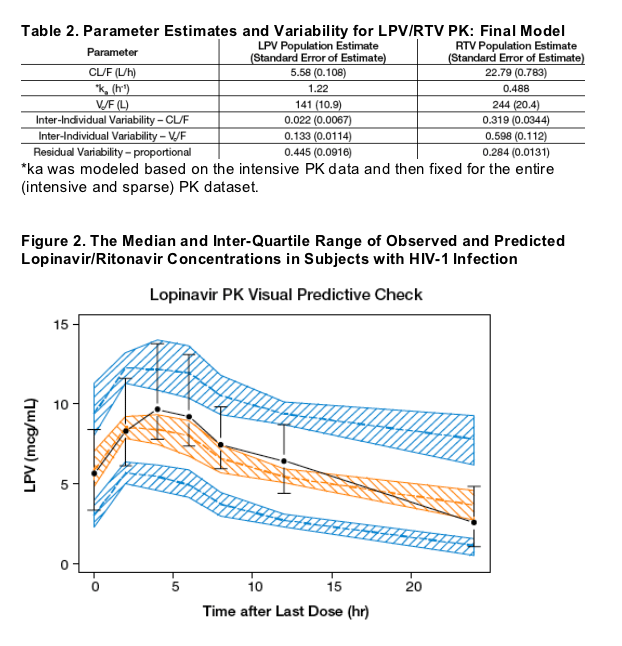
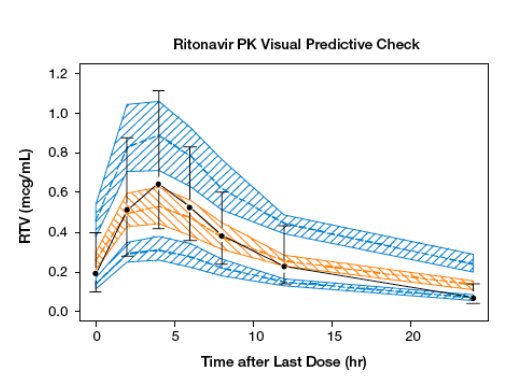
Black circles with error bars show the observed medians and quartiles (25th to 75th percentiles), while the hatched areas show the median and 95% prediction intervals of the quartiles (median [orange] and 25th to 75th [blue]) of 100 simulated trials. Observations are shown at 0, 2, 4, 6, 8, 12, and 24 hours after dose.
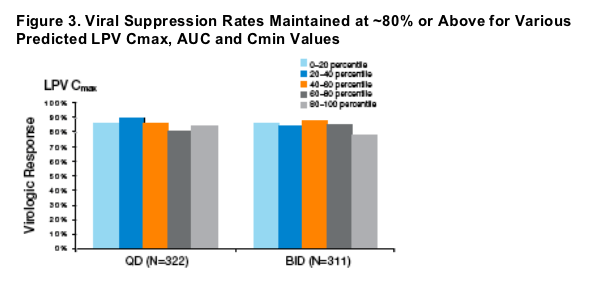
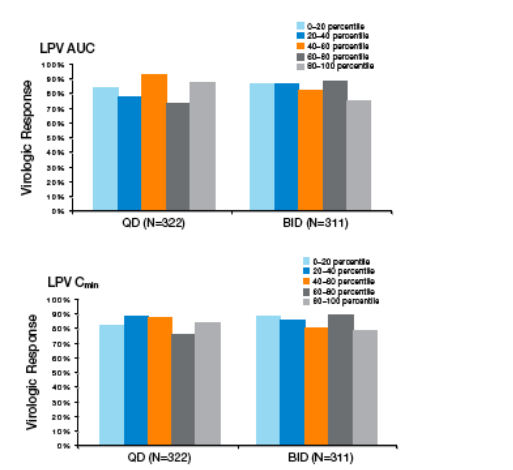
The virologic response did not correlate with LPV levels indicating that, even at the lowest levels measured in this trial, virologic response was maintained
REFERENCES
1. Abbott. A Phase 3, Randomized, Open-label Study of Lopinavir/Ritonavir Tablets versus Soft Gel Capsules and Once Daily versus Twice Daily Administration, when Co-administered with NRTIs in Antiretroviral-Naïve HIV-1 Infected Subjects. (Protocol M05-730) [48 week internal scientific report R&D/08/108]. Abbott Park, Illinois, 2008.
2. Abbott. A Phase 3, Randomized, Open-label Study of Lopinavir/Ritonavir Tablets versus Soft Gel Capsules and Once Daily versus Twice Daily Administration, when Co-administered with NRTIs in Antiretroviral-Naïve HIV-1 Infected Subjects. (Protocol M05-730) [8 week interim internal scientific report R&D/07/450]. Abbott Park, Illinois, 2008.
3. Umeh O, Currier J, Park J G, et al. Sex Differences in Lopinavir/Ritonavir Soft Gel Capsule Pharmacokinetics among HIV Infected Females and Males. Poster 786, CROI, 2007.
4. Bertz R, Lam W, Hsu A, Granneman G R, Sun E. Effects of Gender, Race, Age, and Weight on the Pharmacokinetics of Lopinavir After Single_Dose Kaletra. 2nd International Workshop on Clinical Pharmacology of HIV Therapy, Poster #3,11. Abbott Park, Illinois, 2001.
5. Guidance for Industry. Pharmacokinetics in Patients with Impaired Renal Function-Study Design, Data Analysis, and Impact on Dosing and Labeling. U.S. Department of Health and Human Services, Food and Drug Administration. May 1998.
|
| |
|
 |
 |
|
|